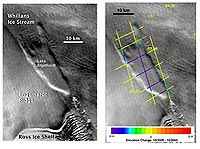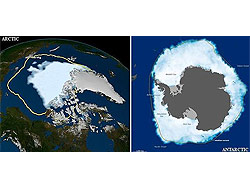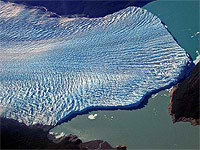Helen Amanda Fricker, del Instituto Scripps de Oceanografía, y su equipo de investigación, analizaron datos obtenidos mediante satélite para documentar el movimiento a larga distancia de las aguas subglaciales que tiene lugar bajo los rápidos flujos de hielo hacia los sitios donde éstas llegan al Océano Antártico. Esta investigación revela nuevas evidencias de la existencia de lagos subglaciales que se drenan entre sí, y su papel en la activación de flujos rápidos de hielo.
Comprender las complejas conexiones hídricas subglaciales de la Antártida es de gran importancia para monitorizar todo el sistema de capas de hielo y su potencial para experimentar cambios.
La masa de hielo antártica es uno de los dos únicos casquetes polares en la Tierra. Los flujos de hielo son componentes de dichas masas heladas los cuales se mueven a mayor velocidad que el hielo circundante. Esos flujos de hielo pueden tener un ancho de hasta 50 kilómetros, un grosor de unos 2, y una longitud de centenares de kilómetros. Los flujos de hielo son responsables del transporte de la mayoría del hielo que abandona el continente hacia las capas de hielo flotante, y, finalmente, hacia mar abierto.
Monitorizar los flujos subglaciales que salen de los márgenes de la capa de hielo es también importante para cuantificar la llegada de agua dulce al océano, así como para comprender la interacción entre el hielo y el mar. El descubrimiento de lagos en lugares donde no existen conductos hacia otros lagos, permite llevar a cabo exploraciones sin correr el riesgo de contaminar otros lagos.
Noticia publicada en Amazings
Enlaces a sitios |
| |
Climbing Magazine Climbing Magazine"s Web site contains more than 30 years of rock and ice climbing news, climber profiles, technical information, and gear reviews. You"ll also find message boards, photo galleries, and classifieds
| Cold Regions Bibliography Between 1999 and 2000, this project was carried out under an Interagency Agreement between the Federal Research Division of the Library of Congress and the U.S. Army Cold Regions Research and Engineering Laboratory (CRREL).
|
Descent into the Ice A tem of "glacionauts" ventures into a labyrinth of unexplored anda hazardous glacier caves on France"s Mont Blanc
| Glacier and Permafrost Hazards in Mountains – GAPHAZ Scientific Working Group of the International Association of Cryospheric Sciences (IACS) and the International Permafrost Association (IPA). Department of Geosciences University of Oslo
|
Glacier hazards The experience and data on glacier disasters in Switzerland has been systematically collected in the past two decades, and historical sources were analyzed.
| Glacier Hazards From Space Glacier hazards represent a continuous threat to human lives and infrastructure in mountain regions.
|
Glacier Hazards in Perú The floods, known in Perú as aluviónes, come with little or no warning and are composed of liquid mud that generally transports large rock boulders and blocks of ice.
| Glaciers and Glacier Hazards Glaciers and Glacier Hazards Glaciers and Ice Sheets and Volcanic Eruptions, USGS/Cascades Volcano Observatory, Vancouver, Washington
|
Glaciers online Glaciers online offers photos and summary explanations concerning glaciers from all over the world. The primary goal of our project is to enrich and stimulate the teaching of Earth Science and Physical Geography, in particular glaciology.. Jürg Alean & Mi
| Global Land Ice Measurements from Space GLIMS (Global Land Ice Measurements from Space) is a project designed to monitor the world"s glaciers primarily using data from optical satellite instruments, such as ASTER (Advanced Spaceborne Thermal Emission and reflection Radiometer).
|











 Imagen: Agencias / Internet
Imagen: Agencias / Internet





